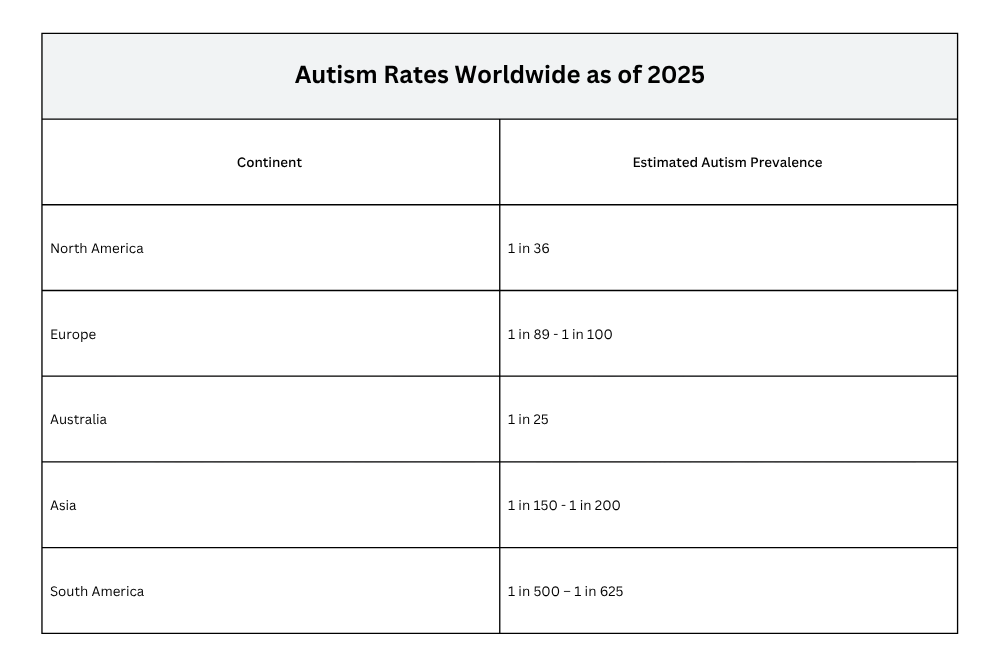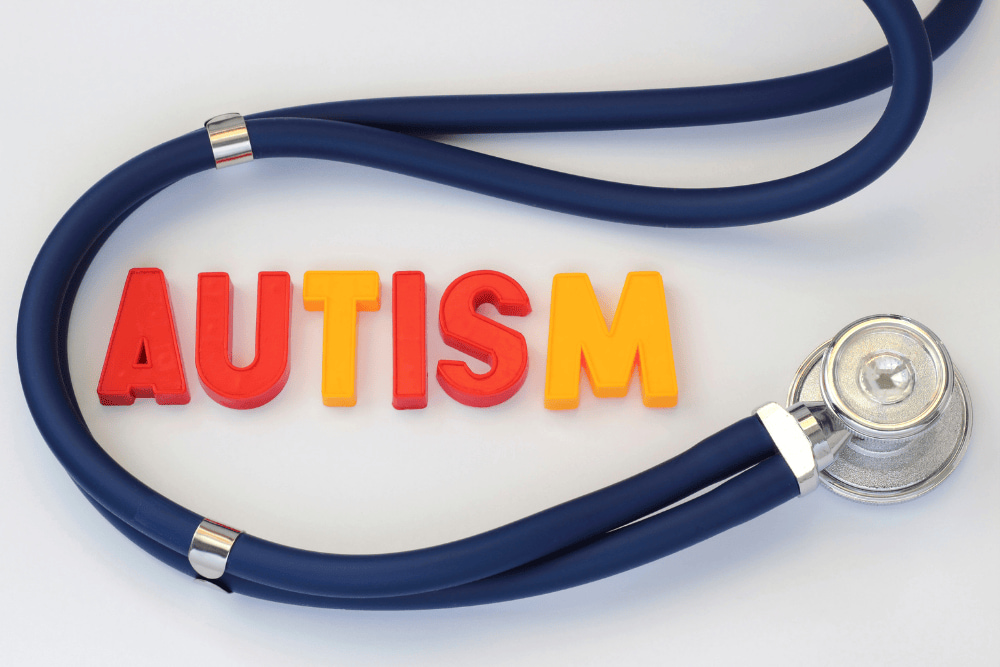Key Takeaways: Why is Autism Increasing?
- Autism rates are increasing, largely due to better awareness, expanded diagnostic criteria, and improved data collection, not because autism is becoming more common.
- Early diagnosis and intervention are more accessible now, allowing children to receive support at younger ages.
- Vaccines do not cause autism—this myth has been thoroughly debunked by extensive scientific research.
- Environmental factors may play a role, but they are not the main cause of increased autism prevalence.
- Global autism trends vary, influenced by culture, healthcare access, and socio-economic factors.
Why Is Autism Increasing? Myths, Facts, and What You Should Know
Recent public discussions, particularly those sparked by Secretary of Health and Human Services Robert F. Kennedy Jr., have brought renewed attention to the rising autism rates and placed the issue back in the national spotlight. Above & Beyond Therapy takes a closer look at what’s behind the increase and what it really means.
The Growing Concern of Autism
Autism is a complex neurodevelopmental disorder that affects communication, social interaction, and behavior. Over the past few decades, there has been a significant increase in the number of individuals diagnosed with autism. This rise in prevalence has caused concern among researchers, healthcare professionals, and families worldwide.
The reasons behind the increase in the number of autism cases are multifaceted. Increased awareness and understanding of autism, changes in diagnostic criteria, and improved data collection methods all play a role in identifying and reporting autism prevalence rates.
Autism Prevalence Rates
Autism prevalence refers to the number of individuals diagnosed with autism in a given population. It is typically reported as a percentage or a rate per a specific population size. Understanding autism prevalence is crucial for policymakers, researchers, and healthcare professionals to allocate resources effectively and provide appropriate support and services to individuals with autism and their families.
Measuring the prevalence rate of autism involves gathering data from various sources, including medical records, surveys, and diagnostic assessments. The prevalence rates can vary depending on the population studied, the age range, and the diagnostic criteria used. It is important to note that prevalence rates may differ between different regions and countries due to variations in data collection and reporting methods.
How is Autism Prevalence Measured?
Measuring autism prevalence requires a systematic approach to data collection and analysis. Researchers and organizations employ various methods to estimate the prevalence rates of autism within specific populations. These methods include:
- Surveillance Studies: These studies involve the systematic monitoring of autism prevalence within a defined geographic area or population. Researchers collect data from multiple sources, such as healthcare providers, educational institutions, and diagnostic centers. By analyzing this data, they can estimate the number of individuals with autism and calculate prevalence rates.
- National Surveys: National surveys are conducted to gather data on the prevalence of autism at a larger scale. These surveys typically involve a representative sample of the population and use standardized screening tools and diagnostic criteria to identify individuals with autism. The collected data helps estimate prevalence rates for the entire country.
- Meta-Analyses: Meta-analyses involve the systematic review and statistical analysis of existing studies on autism prevalence. Researchers combine the data from multiple studies to obtain a more comprehensive understanding of autism prevalence rates across different populations. This method allows for a broader perspective on the overall prevalence of autism.
The increase in autism rates has been on the rise in recent years, prompting many to question the factors contributing to this increase. According to the CDC’s Autism and Developmental Disabilities Monitoring (ADDM) Network, approximately 1 in 31 eight-year-old children in the U.S. were identified with autism spectrum disorder in 2022.
There are several key reasons for the autism increase, including increased awareness and diagnosis, changes in diagnostic criteria, and improved data collection methods.
Increased Awareness and Diagnosis
One significant factor influencing autism prevalence rates is the increased awareness and understanding of autism spectrum disorders (ASD). Over the years, there has been a growing recognition of the diverse range of behaviors and characteristics associated with autism. This increased awareness has led to more individuals seeking a diagnosis for themselves or their children.
Moreover, healthcare professionals and educators have become more knowledgeable about autism, enabling them to identify and diagnose the condition more accurately. This improved understanding has resulted in a higher number of individuals being diagnosed with autism, leading to an apparent increase in prevalence rates.
Changes in ASD Diagnostic Criteria
Diagnostic criteria play a crucial role in determining the prevalence of autism. The criteria for diagnosing autism have evolved over time, which has impacted prevalence rates. The latest edition of the Diagnostic and Statistical Manual of Mental Disorders (DSM-5), published in 2013, introduced significant changes to the diagnostic criteria for autism spectrum disorders.
The DSM-5 consolidated several previously separate diagnoses into a single category of Autism Spectrum Disorder (ASD). This change broadened the diagnostic criteria, allowing for a more inclusive approach to identifying individuals on the autism spectrum. As a result, more individuals who would have previously fallen outside the diagnostic criteria are now being recognized as having autism, contributing to higher prevalence rates.
Improved Autism Data Collection Methods
Another factor influencing autism prevalence rates is the improvement in data collection methods. In the past, data collection relied heavily on clinical records and surveys, which may not have accurately captured the full extent of autism prevalence. However, advancements in research methodologies and a broader range of data sources have allowed for more accurate estimates of autism prevalence.
Large-scale population studies, such as the Centers for Disease Control and Prevention's Autism and Developmental Disabilities Monitoring (ADDM) Network, have been instrumental in collecting comprehensive data on autism prevalence. These studies use standardized screening tools and rigorous methodologies to identify and assess individuals with autism across different geographical areas. The utilization of such robust data collection methods has provided more reliable and precise estimates of autism prevalence rates.
Understanding the factors influencing autism prevalence rates is crucial for gaining insights into the increasing prevalence of autism. By considering the impact of increased awareness and diagnosis, changes in diagnostic criteria, and improved data collection methods, we can better comprehend the complex landscape of autism prevalence.
Analyzing ASD Prevalence Data
To gain a deeper understanding of autism prevalence, it is important to analyze the prevalence data and identify any trends or variations.
Global Trends in Autism Prevalence
Autism prevalence rates vary across different countries and regions around the world. The data collected from various studies and surveys provide valuable insights into the global trends of autism prevalence. While it is important to note that data collection methods and diagnostic criteria may vary, these trends offer a broad perspective on the prevalence of autism.
A comprehensive analysis of global data suggests that autism rates worldwide have been increasing over the years. This increase can be attributed to several factors, including improved awareness, enhanced diagnostic practices, and changes in diagnostic criteria. However, it is essential to approach these trends with caution, as cultural, societal, and economic factors can influence the reported prevalence rates.
Here is a table highlighting the prevalence rates of ASD in different regions:

Variations in Prevalence Rates Across Demographics
Autism prevalence rates can also vary significantly across different demographics, including age, gender, and socio-economic factors. Analyzing these variations provides valuable insights into how autism affects different populations and can help identify potential risk factors or protective factors.
Autism Prevalence Rates Among Different Age Groups
Autism prevalence rates can vary among different age groups. Studies have shown that the prevalence of autism tends to be higher in younger populations compared to older age groups. This may be due to increased awareness, improved diagnosis, and changes in diagnostic criteria over time. Early detection and intervention, which have become more prevalent in recent years, contribute to the higher prevalence rates observed in younger age groups.
The Gender Divide in Autism Rates
Research indicates that autism is more prevalent in males than females. The male-to-female ratio of autism prevalence varies across studies, but it is generally higher in males. This disparity in prevalence rates between genders has been a topic of ongoing research, and various theories have been proposed to explain this difference. However, further investigation is needed to fully understand the underlying factors contributing to this gender disparity.
Socio-economic Factors Contributing to Autism Prevalence
Socio-economic factors can also influence the prevalence rates of autism. Studies have suggested that individuals from lower socio-economic backgrounds may experience higher prevalence rates of autism. This may be due to various factors such as limited access to healthcare services, disparities in diagnostic resources, and challenges in obtaining timely and accurate diagnoses.
Debunking Misconceptions About Autism Prevalence
As the understanding of autism has evolved over the years, various misconceptions have arisen, leading to unfounded beliefs. Let’s address two common misconceptions surrounding autism prevalence: the link between vaccines and autism, and the role of environmental factors.
The Link Between Vaccines and Autism

One of the most pervasive misconceptions surrounding autism is the belief that vaccines, particularly the measles, mumps, and rubella (MMR) vaccine, can cause autism. However, it is important to note that scientific research has consistently debunked this claim. Numerous studies involving large populations have found no credible evidence supporting a causal relationship between vaccines and autism.
The origins of this misconception can be traced back to a now-retracted study published in 1998, which falsely claimed a link between the MMR vaccine and autism. The study has been discredited and retracted due to serious methodological flaws and conflicts of interest. Since then, extensive research conducted worldwide has consistently shown no connection between vaccines and the development of autism.
Public health organizations, including the Centers for Disease Control and Prevention (CDC) and the World Health Organization (WHO), strongly emphasize the safety and importance of vaccines. Vaccines are crucial in preventing serious diseases and have had a significant positive impact on public health. It is important to rely on accurate and evidence-based information when considering the relationship between vaccines and autism.
The Role of Environmental Factors in ASD
Another misconception surrounding autism prevalence is the notion that environmental factors alone are responsible for the increase in autism rates. While environmental factors may play a role in shaping certain aspects of development, research indicates that the primary factors contributing to the observed increase in autism prevalence are related to changes in diagnostic practices and increased awareness.
Over the past few decades, there has been a significant improvement in the recognition and diagnosis of autism. Changes in diagnostic criteria, such as the introduction of the broader diagnostic category of Autism Spectrum Disorder (ASD), have allowed for a more inclusive identification of individuals on the autism spectrum. This expanded diagnostic framework has contributed to a higher prevalence rate as more individuals are now being appropriately diagnosed and included in prevalence studies.
Additionally, increased awareness and improved data collection methods have also played a significant role in the rise of reported autism prevalence rates. Greater awareness has led to more individuals seeking diagnosis and accessing services, resulting in a more accurate representation of the population affected by autism.
It is crucial to understand that while environmental factors may influence certain aspects of autism, they are not the sole cause of the increasing prevalence rates. The complex nature of autism suggests that a combination of genetic, neurological, and environmental factors contributes to its development. Ongoing research aims to further unravel the intricate interplay between these factors.
By addressing and debunking these misconceptions, we can foster a better understanding of autism prevalence and promote accurate information. It is essential to rely on reputable sources and scientific evidence to dispel myths and misconceptions, allowing for a more informed and inclusive society.
Embracing Rising Autism Rates in Today’s World
As autism rates continue to rise, it's important to recognize that this increase reflects a growing awareness, improved diagnostic tools, and greater acceptance. Today, more children are being identified earlier, which means they can access effective therapies and support systems that didn’t exist just a generation ago. With advancements in autism treatment, such as personalized ABA therapy, speech and occupational support, and inclusive education models, autistic individuals have more opportunities than ever to thrive.
At Above & Beyond Therapy, we’re proud to be part of this progress by providing compassionate, evidence-based care tailored to each child’s unique needs. If you’re looking for guidance or support, reach out to us today, we’re here to help your child reach their fullest potential.
FAQ: Why Is Autism Increasing?
Why is autism increasing dramatically?
Autism rates are rising due to improved awareness, expanded diagnostic criteria, and better screening methods. More children are being identified today than in previous decades, not necessarily because autism is becoming more common, but because we’re getting better at recognizing it.
Are boys more likely to be diagnosed with autism than girls?
Yes, autism is currently diagnosed about 3 to 4 times more often in boys than in girls. However, research suggests that autism in girls may be underdiagnosed due to differences in how symptoms appear.
How has autism care improved in recent years?
Autism care has advanced significantly, with better access to ABA therapy, early intervention programs, occupational and speech therapy, and family-centered support. These improvements are helping autistic individuals live more independent and fulfilling lives.
What should I do if I think my child may have autism?
Start by consulting with a pediatrician or developmental specialist for a thorough evaluation. From there, providers like Above & Beyond Therapy can support you through the diagnostic journey and develop a customized care plan tailored to your child’s unique needs.


.jpg)





.png)



